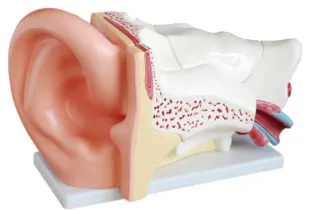Homepageпјҡ NEWS >> Large ear anatomical model: Can it provide more support for clinical training?
In medical education and clinical training, accurate anatomy learning tools are an important means to improve the operational skills and deepen the understanding of students and medical staff. As a core teaching tool in otometry, whether large ear anatomical model can provide more support for clinical training is a key issue in current medical education and clinical skill training.
1. Support the accuracy of clinical training
The anatomical model of the large ear can accurately reproduce the structure of the ear, including the external ear canal, eardrum, middle ear, inner ear and other key parts. By truly reconstructing the anatomy of the ear, medical students and clinicians are able to understand more clearly the relationships between the various structures of the ear, which is crucial for the diagnosis of diseases, the choice of surgical protocols, and the precision of surgical procedures. The precise anatomy allows students to practice repeatedly in a risk-free environment and master key skills in ear surgery, such as eardrum repair and ear canal surgery.

2. Improve the operability of ear surgery training
The big-ear anatomical model not only has high-precision anatomical display function, but also can simulate specific pathological changes according to training needs. For example, the model can simulate common diseases of the ear such as otitis media, blocked ear canal, perforated eardrum, etc., thus enabling students to operate in a simulated environment. The recurrence of this clinical disease helps students not only to understand the ear structure, but also to master how to deal with the complex situation of ear diseases and improve their clinical operation ability.
3. Data support and feedback mechanism
Modern big-ear anatomical models, combined with data technology and sensors, are able to provide real-time operational feedback to help students understand their accuracy and shortcomings in simulation training. For example, when students perform ear surgery simulation, the model can monitor their operation in real time and give feedback on the correctness of the operation based on parameters such as force, Angle, and movement sequence. This data-driven feedback mechanism helps to quickly correct the errors of the trainees, enhance their operational skills, and reduce the risk of future malpractice in the actual clinic.
4. Promote interdisciplinary training
The application of large ear anatomical model is not limited to otolaryngology, it can also be combined with other disciplines to enhance the interdisciplinary training effect. For example, in the fields of audiology, stomatology, plastic surgery, etc., knowledge of ear anatomy is also fundamental. Through the large ear anatomy model, students can comprehensively learn ear anatomy and related diseases, master the links and differences between multiple disciplines, and improve the comprehensive diagnosis and treatment ability.
5. Market demand and education trend
According to market data, with the popularity of medical education worldwide and the growing demand for clinical skills training, the medical simulation equipment market is expanding rapidly. Especially in the field of audiology, the demand for accurate anatomical models and simulation training tools has increased significantly. According to the survey data, in recent years, the global ear training equipment market has maintained a growth rate of about 7% per year, especially in developing countries for high-precision training tools more prominent demand. Anatomical models of the large ear are a key tool to address this trend and provide ongoing support for medical education and clinical training.
Sum up
The large ear anatomical model has become an indispensable tool in the clinical training of the ear with its high-precision anatomical reproduction, data-supported feedback mechanism, and comprehensive support for the operation and diagnosis of the ear. It can not only improve the operational skills of students and doctors, reduce the risk of clinical surgery, but also enhance the diagnosis and treatment ability of students by simulating common ear diseases. As the global demand for medical education continues to grow, especially with the trend of precision medicine and personalized training, large-ear anatomical models will undoubtedly play a greater role in clinical training in the future.